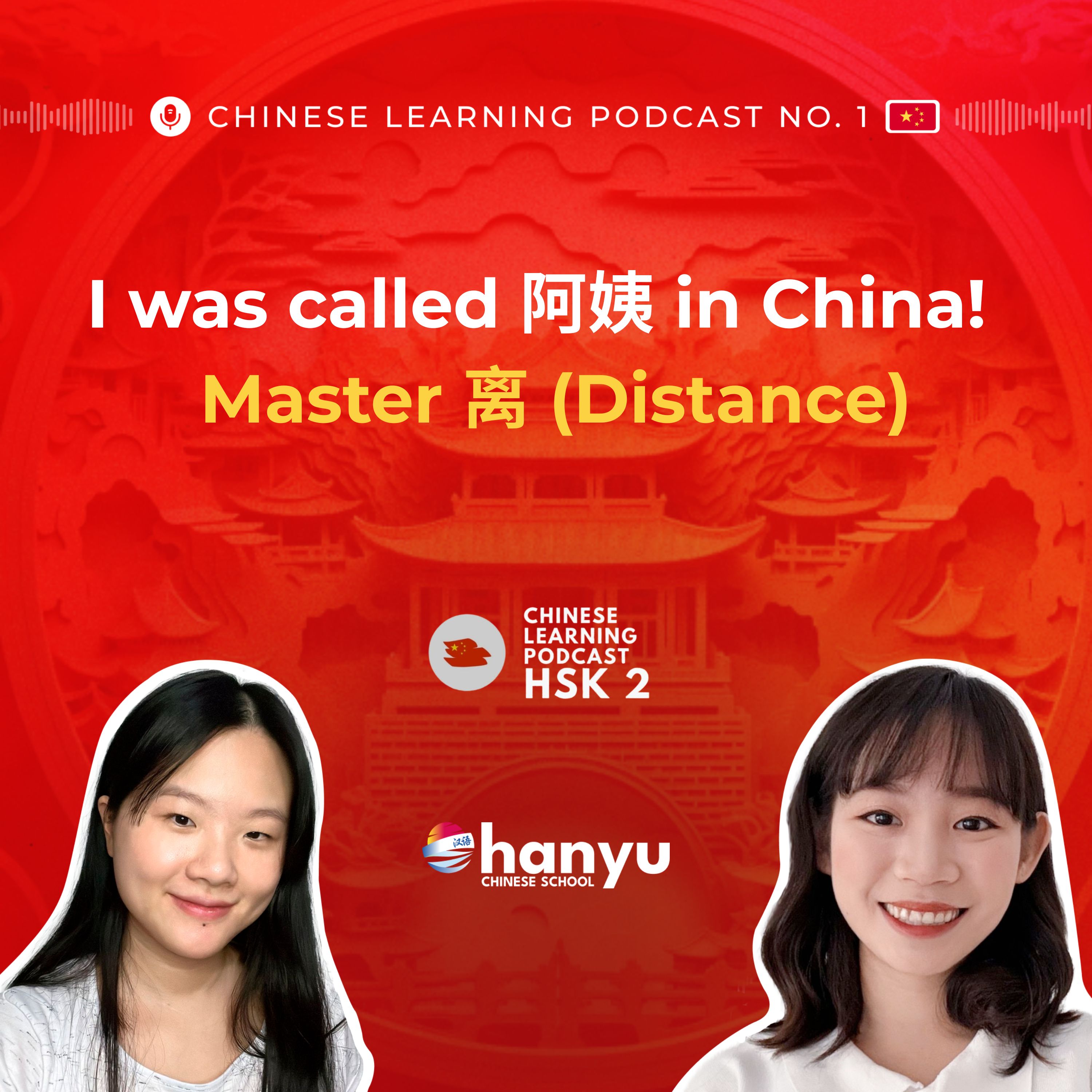Episode Transcript
[00:00:00] Speaker A: Foreign.
Hi everyone.
Welcome Back to the HSK2 Master Class podcast by Hanyu Chinese School. I'm Melanie, your old friend and today I'm always with our wonderful old friend, Vicky Huay. Vicky.
[00:00:28] Speaker B: Hello everyone. I'm Vicky. I'm very happy to come to today's episode. How are you, Melanie?
Today's episode is gonna be very exciting. We're gonna learn about two very useful structure in Chinese. Which is.
[00:00:52] Speaker A: Yes, these two structures are super important because they help you talk about things that have already happened or things that are about to happen very soon. So they're essential if you want to sound natural and fluent in spoken Chinese.
[00:01:11] Speaker B: Yes, we'll use a fun and realistic dialogue to show you how to use them in daily life.
Plus, we'll give you some handy tips.
[00:01:25] Speaker A: So get ready to boost your Chinese with these grammar points and learn some cool phrases you can use immediately.
Okay, so before we start the dialogue and I will introduce myself. I'm Melanie, old friend and I'm your Chinese teacher at Hanyu Chinese School. School. If you're learning Chinese and want to take your skills to the next level, you're going to love this episode. And if you'd like to learn with us, you can try a free one on one class. Through our platform. We have courses starting from €39 with live classes, recorded lessons and full access to our online campus.
So you can learn at your own space.
Please Visit our website hanyuchineschool.com and choose your path.
Okay, so let's start our dialogue for today. So the setting is. Melanie and Vicky are at the subway station. The train is about to arrive. They are walking and chatting. I'll start.
Now let's dive into the two important grammar structures we used in the dialogue.
And.
[00:03:37] Speaker B: Yes, let's start with.
It means already and is used to say that an action or an event has been completed. It tell us something has happened or has finished.
[00:03:55] Speaker A: Yet. For example, in the dialogue I have already bought it here is placed before the verb to buy and is placed after the verb phrase to show completion.
[00:04:14] Speaker B: Yes. And another example from the dialogue is it's already very late at night.
This shows that the state of its being late has already come to.
[00:04:33] Speaker A: So the structure is very useful when you want to emphasize that something is done or has changed. It's not ongoing but complete.
[00:04:49] Speaker B: Next we have.
Which means soon or about to. It used to talk about something that will happen very soon.
[00:05:04] Speaker A: Yeah. So from the dialogue we got, the train is coming soon. The train is about to come.
It's going to Start soon su.
Here cry goes before the verb goes before the verb and the l is added after the verb or verb phrase to show the action is imminent.
[00:05:33] Speaker B: Yes. And you also might see quite, which means the same thing, but sounds a bit more formal or empathetic. So like about two or almost.
[00:05:51] Speaker A: An important note for advanced learners is the role of.
In both these structures it marks a change of state. This is a really important point. So for.
It signals completion for quite. Blah, blah. Look, it signals a transition to a future action that is about to happen.
[00:06:20] Speaker B: Using these structures correctly makes your speech sounds more natural and clear. Especially when you are describing timing or progress.
[00:06:31] Speaker A: And combining them with time. Words like tomorrow, now, ma immediately helps you be even more specific about when something happened or will happen.
[00:06:49] Speaker B: Yes.
So to sum up, the structure is equal to say already plus a completed action, while qu is equal to say soon or about to plus an imminent action.
So master this and you'll describe past and near future events smoothly and naturally.
[00:07:15] Speaker A: Very good.
So let's go back to have some examples.
So here we got.
Blah, blah, blah.
I have already bought it.
It's already very late at night.
And next, Vicky.
[00:07:45] Speaker B: Yes. So we got.
She has already finished her homework.
We have already watched this movie.
[00:08:04] Speaker A: Thank you so much. Let's continue. We got the.
The train is coming soon.
It's going to start soon.
Yes.
[00:08:22] Speaker B: And then we got.
We are about to be late.
It's getting dark soon.
[00:08:35] Speaker A: Thank you very much. Those sentences are very useful. So if you can memorize them and then to make your own sentences based on those example sentences, it will be really, really helpful.
Okay, now it's your turn.
[00:08:54] Speaker B: Yes.
Write a sentence.
How to say I have already finished my hunger in Chinese. Write the sentence below.
We'll be happy to check.
[00:09:11] Speaker A: Yes. So have a try.
Now let's review our dialogue. And please pay attention to the two new grammar structures.
Did you buy the ticket? Don't tell me you haven't bought it yet.
Not yet.
[00:09:48] Speaker B: Yes, I already bought it. Don't worry.
[00:09:58] Speaker A: Great. The train is coming soon. We need to hurry.
[00:10:10] Speaker B: Yes. It's already late at night. I want to go home soon.
[00:10:24] Speaker A: Tomorrow we will already start the new work. Are you ready?
[00:10:35] Speaker B: I'm ready. Let's start soon. But I'm really tired now.
[00:10:48] Speaker A: Me too. But we have already prepared well. We will definitely do well.
[00:10:57] Speaker B: Yes.
Are you enjoying this episode?
With our classes, you can make even more progress. We are the top rated online Academy with over 3,000 satisfied students.
We offer courses starting from just €39, including group class recordings. And 27 learning platform.
So if you like to start, try our free 101 class and you can see it yourself.
Find everything@our website.com or even you can listen all our podcast episode on our campus campus.hanyuchinesschool.com podcast or campustrainland.com podcast.
[00:11:53] Speaker A: Wow, there are so many choices. Exciting.
[00:11:56] Speaker B: So let's start.
[00:11:59] Speaker A: Okay, next, let's take a look. Cultural journey into one of China's most beautiful and profound tradition, Chinese calligraphy.
You might think it's just handwriting, but it's so much more. It's an art form, a way of expressing personality and emotion.
[00:12:24] Speaker B: Absolutely. In fact, calligraphy is considered one of the highest form of Chinese art. It's not just writing characters. It's about the rim, the flow and the energy behind each brushstroke.
[00:12:42] Speaker A: And here's something you might not know.
The tools used in calligraphy are called the four treasures of the study.
The brush, ink paper and ink stone. Each tool is carefully crafted and mastering their use can take a lifetime.
[00:13:07] Speaker B: Yes, and every stock you make can reveal the writer's mood, character and even health.
Ancient Chinese belief, calligraphy was a way to cultivate the mind and body. Kind of like a form of meditation.
[00:13:26] Speaker A: That sounds very special.
And here there are several styles of calligraphy. From the precise and clear regular script, which we called kai shu, to the fast free flowing cursive script which we call some calligraphy can look almost like abstract art. Even native speakers cannot recognize the characters.
[00:13:58] Speaker B: That's true.
Many Western people might not realize this, but in ancient China, calligraphy was more respected than painting or poetry. It was a sign of education, moral character and even social status.
[00:14:20] Speaker A: Yeah, and calligraphy isn't just historical, it's very much alive today. You will see it in everything from elegant signs and logos to public artworks. And during festivals, people write calligraphy couplets to bring good luck. For example, during Chinese Supreme Festival, people writing those to bring good luck.
[00:14:49] Speaker B: Yes. Here's a fun fact.
Many Chinese emperors were themselves skilled calligrapher. Some of the most famous works were royal masterpiece treasure for tensor centuries.
[00:15:05] Speaker A: Oh, and there's a unique cultural aspect. The act of writing calligraphy with a brush requires perfect balance between control and spontaneity, symbolizing the harmony between humans and nature.
[00:15:29] Speaker B: So next time you see Chinese character, remember there's an art philosophy behind those tokens that have been shaping Chinese culture for thousands of years.
[00:15:42] Speaker A: Okay, let's get back to our question.
How would you say I have already finished my homework in Chinese, so the.
[00:15:54] Speaker B: Correct answer Is meaning I have already finished my homework.
[00:16:04] Speaker A: Well done if you got it right. If not, don't worry. Keep practicing. You're improving every day.
[00:16:13] Speaker B: Yes.
So now it's your turn.
Write a sentence using or in the comments below.
You can't talk about something you have already done or something that's gonna happen soon.
[00:16:34] Speaker A: And we love seeing your sentences and helping you improve. So don't be shy, just have a try.
Okay?
So thanks for staying with us until the end. If you want to truly learn Chinese with real teachers and a teacher and a clear method, welcome to Visit our website hanyuchineschool.com and book your free class. We have courses Starting from just €39, live classes, recordings and a complete platform to help you progress step by step. Plus all of our podcasts are organized in the campus so you can track your Progress. We have campus.hanyuchineschool.com podcast and you can go to visit campus.trendland.com podcast. See you in class.
Okay, so today what we have learned, we have learned how to use blah blah to talk about complete actions and cry blah blah to talk about things happening soon.
[00:17:54] Speaker B: Yes. And we also discover the amazing culture behind Chinese calligraphy. It's an art that combinates writing, personality and philosophy.
[00:18:06] Speaker A: In the next episode we will dive into two very important verbs and you will learn how to express wants, intentions and desires clearly and naturally in Chinese.
[00:18:23] Speaker B: Yes.
Make sure to subscribe so you don't miss this the next episode. And you keep practicing. You keep practicing what you have learned today.
If you like the episode, don't forget to also give us a like to today episode.
[00:18:40] Speaker A: Yes. And you can also share this with your friends and family members who are also learning Chinese so you can making progress together. And remember if you want to.
If you want some personalized help, welcome to visit our website to book your free trial class with a native teacher. And thanks for listening today. We will see you next time.
Bye bye.


